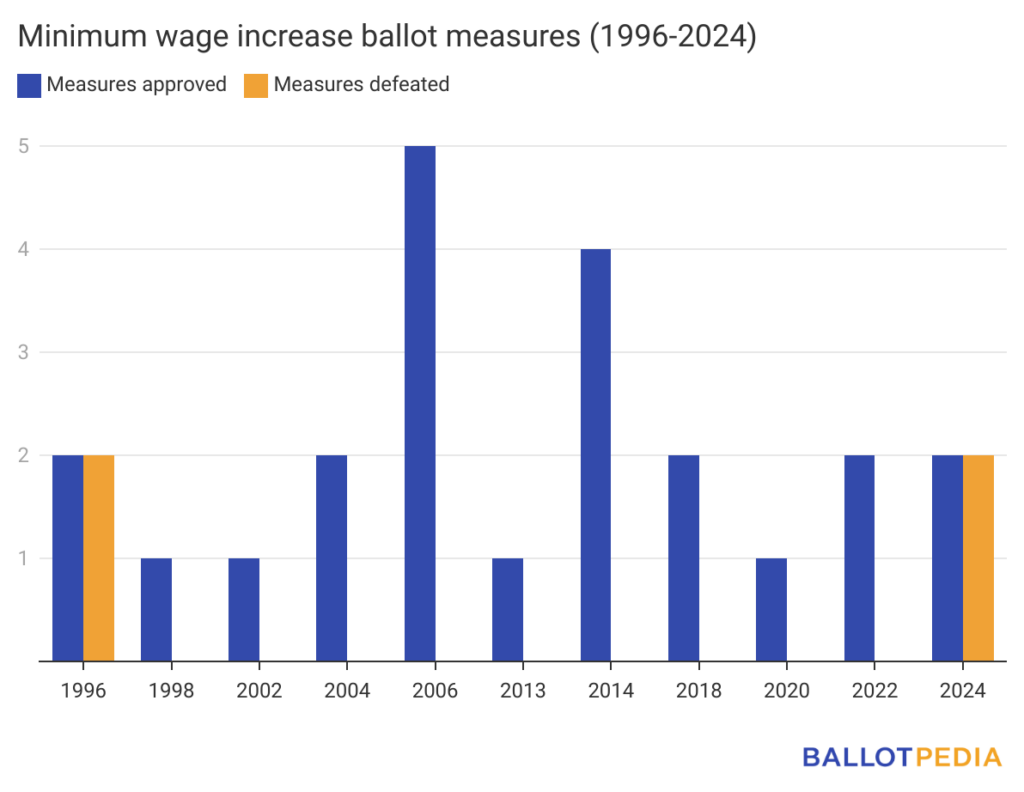In 2025, the minimum wage will increase in 23 states and Washington, D.C. The increases range from $0.25 in Montana and Ohio to $2.15 in Michigan.
The 2025 increases come from state laws adopted in the past that provided for incremental increases and inflation adjustments as well as voter approval of minimum wage increase ballot measures on the 2024 ballot in Alaska and Missouri.
Nineteen states will see increases take effect on Jan. 1, 2025. One state, Michigan, was set to have two increases—one on Jan. 1 and one on Feb. 21. Increases in two states (Alaska and Oregon) and Washington, D.C. were set to take effect on July 1, and one was set to take effect in Florida on Sept. 30.
The average state minimum wage, including D.C., in 2025 will be $11.18, up from $10.69 in 2024.

Highest and lowest state minimum wages:
The highest state minimum wage in 2025 will be in Washington, D.C., which had a minimum wage of $17.50 effective July 2024 with another increase to be calculated in July 2025. The states with the top three highest wages in 2025 are Washington ($16.66 per hour), California ($16.50 per hour), and Connecticut ($16.35 per hour).
The minimum wage is the lowest in Georgia and Wyoming, where the $5.15 minimum wages are superseded by the federal government’s $7.25 per hour requirement. Going into 2024, 20 states used the federal minimum wage rate of $7.25, and 30 states provided for state minimum wages above the federal minimum wage.
Largest and smallest increases in 2025:
Michigan will have the largest increases in 2025 from its 2024 rate of $10.33 after an increase to $10.56 on Jan.1 and to $12.48 on Feb. 21, an increase of 20.81%. The two increases were ordered by the state supreme court on July 31, 2024, after it ruled that the state legislature's action to adopt-and-amend a 2018 initiative was unconstitutional. The ballot initiative was designed to increase the state's minimum wage between 60 and 75 cents each year until reaching $12.00 in 2022; thereafter, the initiative was designed to raise the minimum wage based on inflation. On December 4, 2018, the state legislature amended the indirect initiative to increase the minimum wage to $12.05 by 2030. Gov. Rick Snyder (R) signed the bill on December 4, 2018.
Montana and Ohio will have the smallest increases in 2025 with the states' wages increasing by 25 cents. Montana's minimum wage will increase from $10.30 to $10.55 on Jan. 1, 2025. In 2006, voters approved Initiative 151, which increased the minimum wage to $6.15 in 2007 and indexed the minimum wage to inflation beginning in 2008. Ohio's minimum wage will increase from $10.45 to $10.70 on Jan. 1, 2025. In 2006, voters approved Amendment 2, which increased the minimum wage to $6.85 in 2007 and indexed the minimum wage to inflation beginning in 2008.

Minimum wage ballot measures on the 2024 ballot:
Voters in Alaska and Missouri approved minimum wage increase ballot measures.
- Missouri voters approved Proposition A, which will increase the minimum wage to $15 in 2026 and enact paid sick leave requirements.
- Alaska voters approved Ballot Measure 1, which will increase the minimum wage to $15 in 2027 and enact paid sick leave requirements. The initiative also prohibits employers from taking adverse action against employees who choose not to attend employer-sponsored meetings on religious or political matters.
California and Massachusetts became the first states to reject minimum wage increase ballot measures since 1996. The other two defeated measures were on the ballot in 1996 in Missouri and Montana.
- In California, voters rejected Proposition 32, which would have increased the minimum wage to $18 per hour. This was the highest proposed minimum wage ever appearing on a statewide ballot.
- Voters in Massachusetts rejected Question 5, which would have increased tipped employees’ wages to meet the state minimum wage.The minimum wage for tipped employees in Massachusetts is $6.75, and the minimum wage for non-tipped employees is $15.

From 1996 to 2024, there were 32 ballot measures to increase state minimum wages. Voters approved 28 (87.50%) and rejected four (12.50%)
Additional reading:


